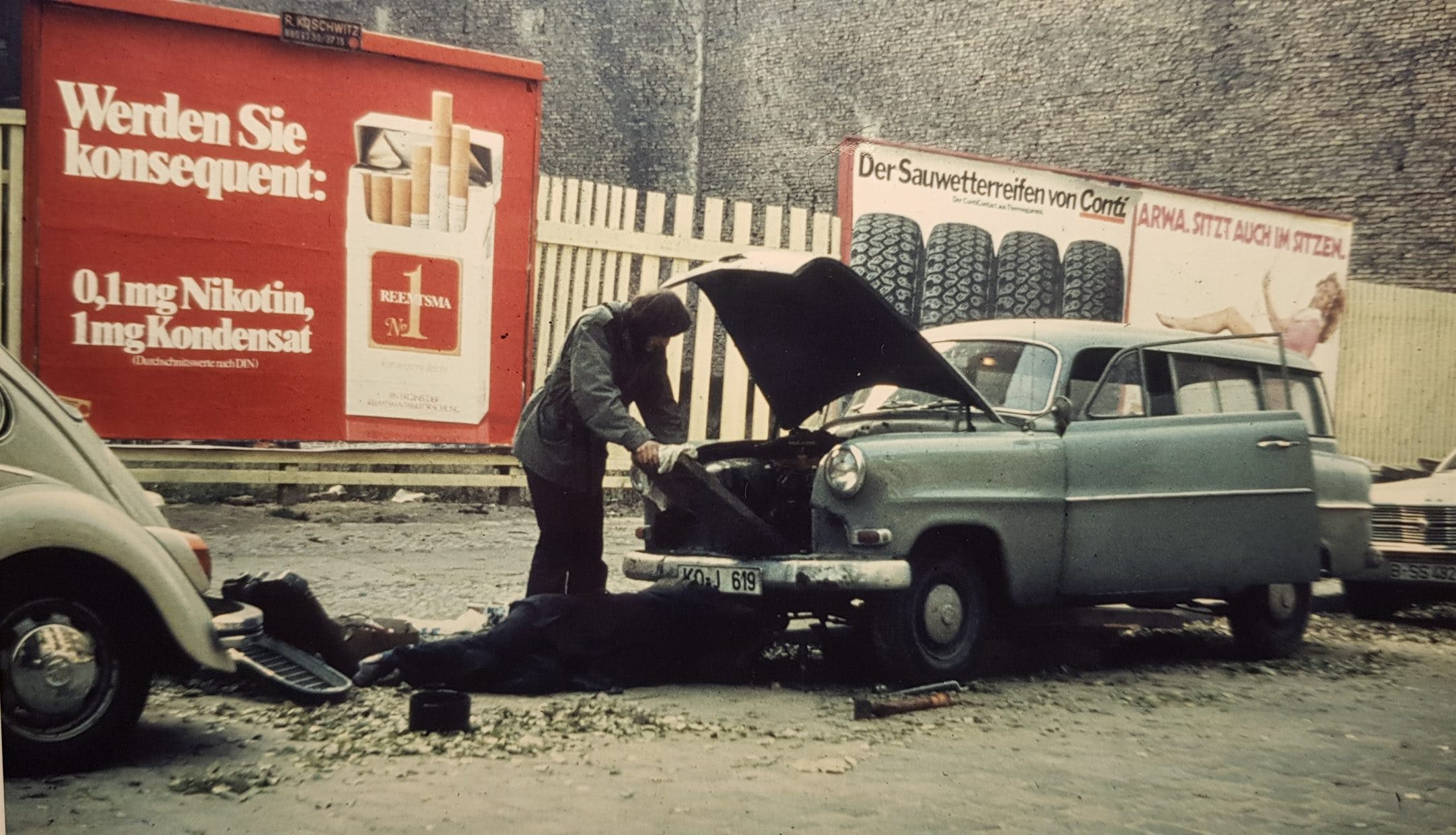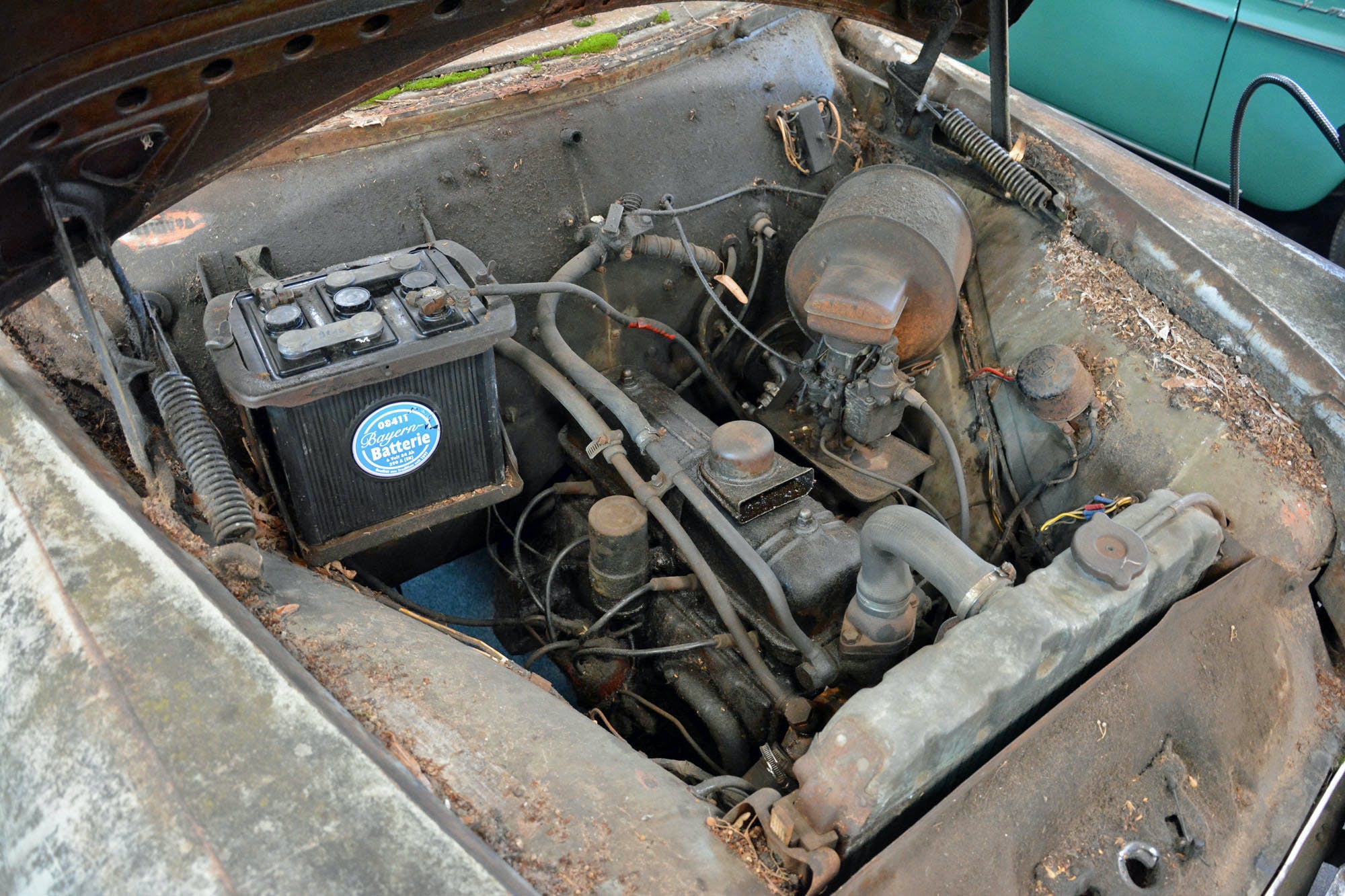My philosophy is that I leave the car as-is, and I don’t change anything. It’s like Yellowstone National Park: If there’s a fire, they let it burn, because it’s nature. Here, I say what happens, happens.”
That’s Hanns-Lüdecke Rodewald, a German engineer and professor, speaking while giving me a tour of his 1956 Opel Olympia Caravan. He meant it. Rodewald hasn’t washed his three-door wagon since 1977.

It’s not a classic in the generally accepted sense. It’s a mechanical and legal experiment.
“I purchased it in 1976. I drove it a little bit and a year later tried to sell it. Nobody wanted it! I was asking 500 DM for it, so about 250 euros. Everything was working, but it was like trying to sell an old Volkswagen Golf today. Difficult. I ended up keeping it,” he says.

You would have kept it, too. Rodewald bought the car from its original owner. A photo he took of it in ’76 shows the Opel to have been fairly well-kept. It was standard, finished in Verona Green, and it had stood the test of time relatively well – especially for a car first registered in March of 1956. It became an experiment: Rodewald set out to see how long the Caravan would survive if he limited repairs to only those needed to pass inspections.
Keep in mind the location. This is Germany, where TÜV standards border on draconian. In November 2021, the Association of German TÜV organisations announced that 20 per cent of German road cars inspected between July 2020 and June 2021 were found to have a “major fault.” Rodewald had just volunteered the little Opel for the fight of its life.


Nor did he spare it. The Caravan gained a roof rack for the hauling of construction material, and the 1.5-litre, 45-hp four-cylinder sometimes found itself towing heavy, double-axle trailers. Dents and surface rust invited themselves onto the body as the paint gradually faded away. And yet, the Opel received regular oil and filter changes, it slurped high-quality petrol, and it always passed the TÜV road worthiness inspection. That’s a testament to both Rodewald’s mechanical skills and to Opel’s 1950s build quality.
Rodewald is an automotive engineer, and he’s performed much of the Opel’s repairs and maintenance, sometimes on the streets of Berlin. The odometer displayed 89,000 kilometers (around 55,400 miles) in 1976; it now shows precisely 169,391 (105,254 miles). In addition to wear-and-tear parts like tyres and brake pads, Rodewald has replaced the camshaft gear, an exhaust valve, and the clutch.



While his initial experiment aimed to figure out how to keep a car on the road with the least amount of effort, nearly 50 years of ownership have shed light on another important scientific question: what happens to a car when it’s not washed. “I counted two types of moss on your car,” I tell him. “No,” he says, “there are three, because there’s another type here.” He points to the rear door. “Look, the yellow one.”
Parked on public roads, Rodewald’s Opel has become a famous sight in Berlin. The car is often photographed by tourists, and car enthusiasts have offered to buy it. Various messages are etched in the layer of grime that the car wears like a winter coat: hearts, phone numbers, initials. The Caravan went viral in a way, too: Several major publications have used a photo of the hood emblem to illustrate stories about Opel’s near-collapse in the late 2000s and early 2010s.



Predictably, local officials have been less than amused by this study in extreme patina. Berlin is one of those cities where low-emissions regulations, designed to keep older cars out of certain zones, are strictly enforced. One way to circumvent this rule is to get a vintage car registered as a historic vehicle, but the Opel is far too haggard to be ranked a “vehicle of cultural value” by the German government. Run-ins with law enforcement have been frequent, and the government forced the Opel off the road for a year and a half in the mid-1990s. Undeterred, Rodewald appealed the decision, won, and was even awarded a small settlement.
In 2017, after slashing his way through 15 criminal complaints, Rodewald was granted permission to keep the car in Berlin’s low-emissions zone. The first 14 complaints didn’t lead to a conviction because he proved to the court that he didn’t start the car inside the low-emissions zone; he had been winching it onto a trailer and starting it outside the boundary. The result was an 80-euro fine (less than £70) for the final complaint, because the judge feared that Rodewald would try to drive the car at night.




Rodewald remembers this as the experiment’s first real challenge. He appealed that decision and ultimately received a special permit by leveraging the car’s status as a tourist attraction. He’s now allowed to start the engine inside Berlin’s Umweltzone, and he can drive the Opel in the area for up to 500 kilometres (310 miles) annually. Other cities have been more welcoming: He was invited to display his Olympia at the 2021 German International Motor Show, in Munich, next to a fully restored Olympia sedan.
Rodewald keeps his Opel registered and in running condition, but he no longer takes it on long trips. “I’m afraid that, if I get into an accident, there are no seatbelts, no airbags, and the steering column isn’t collapsible,” he said. (Adding seatbelts would be difficult, because the car has no anchor points.)
What’s next largely depends on driving and parking regulations in Berlin. And on the car itself.

“There is no date to stop the experiment. It depends on future political regulations. One of the coming problems is the residential parking permit I need for this car. Everybody [in Berlin] can apply for only one car. I need to decide whether to get one for my other, new car, or for the old Opel.”
Stricter emissions-related regulations at the city level would be problematic as well. “Maybe only electric cars will be allowed to drive in Berlin at some point,” he said. “This will be a challenge, but not the end.”
Read more
Magnus Walker drives the world’s highest mileage car
Dieter Klein travels the world in the quest for the perfect photograph of abandoned cars
Life’s a beach: The new generation taking on Bruce Meyer’s dune buggy








My 74 Land Rover Lightweight has not been washed since 2009 when I bought it.
It also has various mosses and lichens.
Washing cars is such a waste of time.